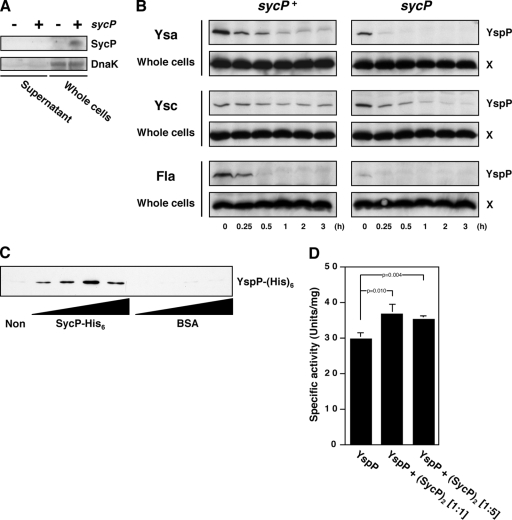FIG. 5.
Role of SycP on the stability, solubility, and activity of YspP. (A) Intracellular localization of SycP. GY5774 carrying either pGY666 (sycP; −) or pGY911 (sycP+; +) were grown in Ysa-inducing medium and then separated by centrifugation. The samples of supernatant (OD600 of 1) and whole-cell (OD600 of 0.1) fractions were analyzed by Western blotting using an anti-SycP antiserum and a monoclonal anti-DnaK antibody. (B) Stability of YspP in the sycP+ strains and sycP mutants. GY5774 carrying either pGY911 (sycP+) or pGY666 (sycP) was grown in Ysa-, Ysc-, or flagellum (Fla)-inducing medium for 3 h. Following addition of chloramphenicol to the medium, the bacterial cells were collected at the indicated times. The lysed cells (OD600 of 0.1) were analyzed by Western blotting using anti-YspP antiserum. A cross-reactive protein, labeled X, that was detected by anti-YspP antiserum served as a loading control. (C) Rescue of insolubilized YspP by SycP. Thirty micrograms of purified insoluble YspP-His6 was incubated without (Non) or with increasing concentrations of purified SycP-His6 or BSA (1.25 μg, 2.5 μg, 5.0 μg, and 10 μg) in a total reaction volume of 100 μl. Following the centrifugation to remove the remaining insoluble YspP-His6, 10 μl of the cleared supernatants was analyzed by Western blotting using anti-His6 antibody. (D) PTPase activity of YspP in the presence of SycP. Purified YspP-His6 was incubated without or with purified SycP-His6 at the indicated molar ratios. Following incubation, their PTPase activities were examined as described in Materials and Methods. The data were obtained from three independent experiments, and the P values were calculated using Student's two-tailed t test.

